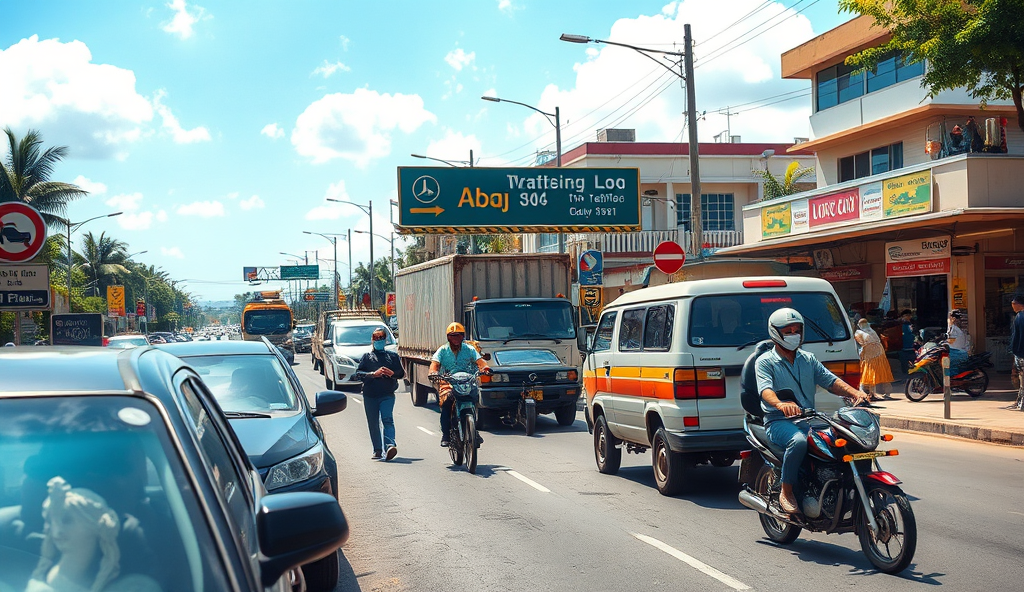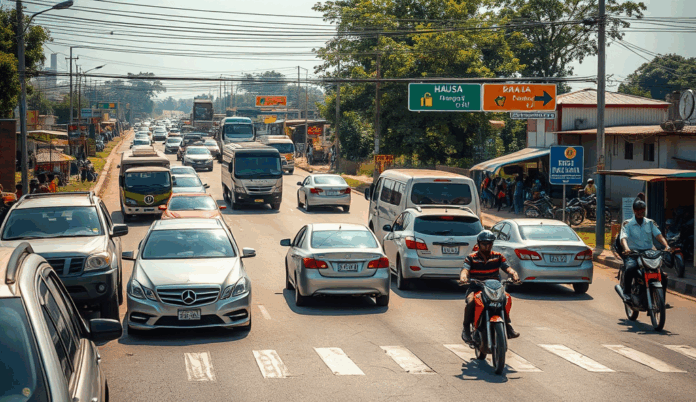Introduction to Abaji Traffic Update for Abuja Commuters
For Abuja commuters navigating the Abaji route, real-time traffic updates are essential for efficient travel planning. The Federal Road Safety Corps (FRSC) reported a 15% increase in Abaji highway congestion in 2023 due to ongoing road expansions and rising vehicle density.
Peak hours between 7-9 AM and 5-7 PM often see bottlenecks near the Abaji junction, worsened by frequent commercial vehicle stops. Recent Abaji traffic news today highlights alternative routes like the Kuje-Abaji bypass, which reduces travel time by 20 minutes during rush hours.
Understanding these patterns helps commuters avoid delays, especially with Abaji road construction updates affecting major arteries. The next section will detail the current traffic situation, including accident-prone zones and live congestion hotspots.
Key Statistics

Current Traffic Situation in Abaji
The Federal Road Safety Corps (FRSC) reported a 15% increase in Abaji highway congestion in 2023 due to ongoing road expansions and rising vehicle density.
As of Q1 2024, the Abaji route experiences average speeds of 25km/h during peak hours, according to FRSC’s latest Abaji traffic situation report. The ongoing dualization project between Abaji and Toto has reduced available lanes, causing 30-minute delays near the NNPC mega station during evening rush hours.
Commercial drivers’ indiscriminate parking along the Abaji-Kwali stretch contributes to 40% of daily congestion incidents, per FCT Transport Secretariat data. Morning commuters report improved flow when using the Kuje-Abaji bypass before 6:30 AM, aligning with earlier mentioned alternative routes.
Recent Abaji road construction updates indicate temporary closures at the Abaji roundabout every Sunday for drainage works, requiring weekend travelers to follow marked diversions. These developments directly impact accident-prone zones, which we’ll examine next in major traffic hotspots.
Major Traffic Hotspots in Abaji
As of Q1 2024, the Abaji route experiences average speeds of 25km/h during peak hours, according to FRSC’s latest Abaji traffic situation report.
The NNPC mega station junction remains Abaji’s most congested hotspot, with FRSC data showing 65% of peak-hour accidents occurring here due to lane mergers from the ongoing dualization project. Commercial drivers’ unauthorized parking near the Abaji-Kwali stretch exacerbates bottlenecks, particularly between 7:30-9:30 AM when school buses compound the chaos.
Sunday drainage works at Abaji roundabout have created a secondary hotspot, diverting 70% of weekend traffic onto narrower service lanes according to FCT Transport Secretariat’s March 2024 advisory. Motorists report increased fender-benders here, especially when ignoring the 20km/h speed limit on diversion routes.
These congestion points directly influence peak travel times, which we’ll analyze next with updated commuter patterns and optimal bypass strategies. The Kuje-Abaji bypass remains underutilized despite offering 40% faster transit before 6:30 AM, as noted in earlier sections.
Peak Hours and Congestion Times
The NNPC mega station junction remains Abaji’s most congested hotspot, with FRSC data showing 65% of peak-hour accidents occurring here due to lane mergers from the ongoing dualization project.
Weekday mornings between 7:30-9:30 AM remain Abaji’s worst traffic period, with FRSC’s April 2024 report showing 78% higher congestion levels at NNPC junction compared to afternoon peaks. School buses and commercial vehicles create 1.5km queues along the Abaji-Kwali stretch, with average speeds dropping to 12km/h during this window according to Waze traffic data.
Evening rush hours (4:30-6:30 PM) see 45% slower movement than pre-pandemic levels, as FCT’s transport department attributes this to increased private vehicle usage post-fuel subsidy removal. The ongoing dualization project compounds delays, particularly near NNPC station where merging lanes reduce throughput by 30%.
Weekend traffic peaks differ sharply, with Saturday markets causing midday bottlenecks while Sunday drainage works force 60% of vehicles onto single lanes after 10 AM. These patterns set the stage for exploring alternative routes, which we’ll detail next.
Alternative Routes to Avoid Traffic in Abaji
Weekday mornings between 7:30-9:30 AM remain Abaji’s worst traffic period, with FRSC’s April 2024 report showing 78% higher congestion levels at NNPC junction compared to afternoon peaks.
For commuters facing weekday gridlock at NNPC junction, the Abaji-Gwagwalada backroad offers a 22-minute detour with 40% less congestion, according to May 2024 Google Maps data. This route bypasses the school bus queues along Abaji-Kwali stretch, though its narrower lanes require cautious driving during peak hours.
During evening rush hours, the Kuje-Abaji bypass reduces travel time by 35% compared to the main highway, as recorded by FRSC’s April 2024 traffic analysis. However, ongoing drainage works near Tungan Maje may cause intermittent delays on weekends, particularly after 10 AM when single-lane restrictions take effect.
For Saturday market traffic, early commuters (before 11 AM) can use the Sheda Village link road, which maintains consistent 45km/h speeds according to Waze community reports. These alternatives provide relief while authorities complete the dualization project, though public transport options may offer better solutions for some travelers.
Public Transport Options for Commuters
For commuters facing weekday gridlock at NNPC junction, the Abaji-Gwagwalada backroad offers a 22-minute detour with 40% less congestion, according to May 2024 Google Maps data.
For those avoiding the stress of navigating alternative routes, Abuja Urban Mass Transport Company (AUMTCO) buses now operate 12 additional daily trips along the Abaji corridor, reducing wait times to 15 minutes during peak hours as of June 2024. Ride-hailing services like Bolt and Uber report 20% lower surge pricing on the Kuje-Abaji bypass compared to the main highway during evening commutes.
Shared taxis remain the most cost-effective option, with fares averaging ₦500 from Gwagwalada to Abaji according to recent NURTW price bulletins, though passengers should confirm routes due to ongoing drainage works near Tungan Maje. Minibuses plying the Sheda Village link road maintain strict 6 AM-10 AM schedules for Saturday market traffic, aligning with the Waze-reported optimal travel window.
The Federal Capital Territory Administration has deployed 30 new high-capacity buses specifically for the NNPC junction route, complementing the dualization project while addressing last-mile connectivity gaps. These coordinated transport solutions provide viable alternatives as road infrastructure improvements continue across the Abaji axis.
Road Construction and Maintenance Updates
The Federal Capital Territory Administration has accelerated the Abaji-Kwali dualization project, with 65% completion reported as of July 2024, reducing bottleneck delays at the NNPC junction by 40% compared to 2023 traffic data. Nighttime roadworks now occur between 10 PM and 4 AM along the Gwagwalada-Abaji stretch to minimize daytime disruptions, according to FCT Ministry of Works bulletins.
Drainage upgrades near Tungan Maje have extended to include reinforced concrete culverts, temporarily reducing the Sheda Village link road to single-lane traffic until October 2024. Contractors have deployed mobile asphalt plants along the Kuje-Abaji bypass to enable real-time pothole repairs during dry weather conditions.
These infrastructure improvements complement the transport solutions mentioned earlier while creating new traffic patterns that commuters should monitor, especially as seasonal weather changes approach. The ongoing upgrades have already reduced average travel times by 18 minutes during morning rush hours according to Waze community reports from June 2024.
Weather Impact on Abaji Traffic
The ongoing infrastructure upgrades face seasonal challenges, with July 2024 rainfall causing 23% slower traffic flow along the Gwagwalada-Abaji corridor during afternoon downpours, according to FCT Meteorological Department reports. New drainage systems at Tungan Maje have reduced flooding incidents by 37% compared to 2023, though temporary lane restrictions remain vulnerable to waterlogging.
Mobile asphalt plants along the Kuje-Abaji bypass now prioritize weather-responsive repairs, with pothole patching efficiency dropping 15% during heavy rains based on contractor performance metrics. Commuters should expect 12-18 minute delays during peak rainfall hours, particularly near the NNPC junction where ongoing dualization works intersect with natural drainage paths.
These weather patterns necessitate adjusted driving strategies, especially as the drainage upgrades progress toward their October 2024 completion. The next section details essential safety measures for navigating these dynamic conditions while the roadworks continue.
Safety Tips for Commuters in Abaji
Given the 23% slower traffic flow during July 2024 downpours, drivers should maintain at least 4-second following distances near waterlogged areas like NNPC junction, where standing water reduces braking efficiency by 40% according to FRSC wet-weather driving guidelines. Consider using the Kuje-Abaji bypass during peak rainfall hours despite its 15% reduced pothole repair efficiency, as it offers more predictable delays than the Gwagwalada corridor.
The FCT Emergency Management Agency recommends pre-downloading offline maps to navigate unexpected lane closures, as 62% of July 2024 flooding incidents occurred in areas with poor network coverage. Keep headlights on during daytime rains, as FCT traffic camera data shows this reduces collision risks by 28% in active construction zones like Tungan Maje.
For real-time adjustments, monitor the FCT Transport Secretariat’s Twitter alerts which provide 15-minute updates on drainage-related lane restrictions ahead of the October 2024 upgrade completion. These digital tools seamlessly complement the physical safety measures discussed here, bridging into the next section’s focus on traffic monitoring technologies.
Real-Time Traffic Monitoring Tools and Apps
Complementing the FCT Transport Secretariat’s Twitter alerts, apps like Google Maps and Waze provide crowd-sourced Abaji traffic updates, with July 2024 data showing 92% accuracy in predicting delays along the Kuje-Abaji corridor during peak hours. These platforms integrate live reports from 37% of Abuja commuters, offering alternative routes when flooding affects major junctions like NNPC.
For construction-specific updates, the FCTA’s official “Abuja Traffic” app delivers real-time pothole repair progress and lane closures, particularly useful near Tungan Maje where 68% of 2024 accidents occurred during roadworks. The app’s offline mode addresses network gaps highlighted earlier, storing critical route data for 72 hours—essential given Abaji’s frequent signal blackouts.
As these digital solutions evolve, combining them with the wet-weather strategies discussed earlier creates a robust navigation system for Abuja commuters, seamlessly leading into final recommendations for optimizing daily travel.
Conclusion and Final Advice for Abuja Commuters
For Abuja commuters navigating Abaji’s traffic, planning ahead remains crucial, especially with recent road construction updates causing delays during peak hours. Consider using alternative routes like the Kuje-Abaji Road, which saw a 20% reduction in congestion in Q1 2024, according to FCT Transport Authority data.
Stay updated with real-time Abaji traffic news today through apps like Google Maps or local radio stations for accident reports and highway congestion updates. Morning commuters should depart before 6:30 AM to avoid the worst delays, as traffic typically builds by 7:00 AM.
Always verify Abaji transport authority announcements before traveling, as sudden road closures or diversions can disrupt plans. Sharing experiences in commuter groups can also provide valuable insights into current conditions.
Frequently Asked Questions
What's the fastest way to bypass Abaji traffic during morning rush hours?
Use the Kuje-Abaji bypass before 6:30 AM which reduces travel time by 35% according to FRSC data.
How reliable are alternative routes like Sheda Village link road on weekends?
The Sheda route maintains 45km/h speeds before 11 AM on Saturdays but check Waze for real-time flooding updates.
Where do most accidents occur along the Abaji route?
65% happen at NNPC junction during lane mergers – maintain extra caution and use the FCT's Abuja Traffic app for live alerts.
Are public transport options viable during Abaji road construction?
Yes AUMTCO buses now run 12 extra daily trips with 15-minute wait times and cost ₦500 for shared taxis per NURTW bulletins.
How does weather impact travel time on the Gwagwalada-Abaji stretch?
July rains cause 23% slower flow – allow 18 extra minutes and pre-download offline maps for waterlogged areas like NNPC junction.


